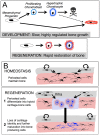Ihha induces hybrid cartilage-bone cells during zebrafish jawbone regeneration
- PMID: 27122168
- PMCID: PMC4920169
- DOI: 10.1242/dev.131292
Ihha induces hybrid cartilage-bone cells during zebrafish jawbone regeneration
Abstract
The healing of bone often involves a cartilage intermediate, yet how such cartilage is induced and utilized during repair is not fully understood. By studying a model of large-scale bone regeneration in the lower jaw of adult zebrafish, we show that chondrocytes are crucial for generating thick bone during repair. During jawbone regeneration, we find that chondrocytes co-express genes associated with osteoblast differentiation and produce extensive mineralization, which is in marked contrast to the behavior of chondrocytes during facial skeletal development. We also identify the likely source of repair chondrocytes as a population of Runx2(+)/Sp7(-) cells that emanate from the periosteum, a tissue that normally contributes only osteoblasts during homeostasis. Analysis of Indian hedgehog homolog a (ihha) mutants shows that the ability of periosteal cells to generate cartilage in response to injury depends on a repair-specific role of Ihha in the induction as opposed to the proliferation of chondrocytes. The large-scale regeneration of the zebrafish jawbone thus employs a cartilage differentiation program distinct from that seen during development, with the bone-forming potential of repair chondrocytes potentially due to their derivation from osteogenic cells in the periosteum.
Keywords: Bone regeneration; Chondrocyte; Chondroid bone; Ihha; Jaw; Osteoblast; Zebrafish.
© 2016. Published by The Company of Biologists Ltd.
Conflict of interest statement
The authors declare no competing or financial interests.
Figures







Similar articles
-
Characterization of two new zebrafish members of the hedgehog family: atypical expression of a zebrafish indian hedgehog gene in skeletal elements of both endochondral and dermal origins.Dev Dyn. 2006 Feb;235(2):478-89. doi: 10.1002/dvdy.20619. Dev Dyn. 2006. PMID: 16292774
-
Shh promotes direct interactions between epidermal cells and osteoblast progenitors to shape regenerated zebrafish bone.Development. 2017 Apr 1;144(7):1165-1176. doi: 10.1242/dev.143792. Development. 2017. PMID: 28351866 Free PMC article.
-
Sox9 positive periosteal cells in fracture repair of the adult mammalian long bone.Bone. 2017 Oct;103:12-19. doi: 10.1016/j.bone.2017.06.008. Epub 2017 Jun 13. Bone. 2017. PMID: 28627474 Free PMC article.
-
The extended chondrocyte lineage: implications for skeletal homeostasis and disorders.Curr Opin Cell Biol. 2019 Dec;61:132-140. doi: 10.1016/j.ceb.2019.07.011. Epub 2019 Sep 18. Curr Opin Cell Biol. 2019. PMID: 31541943 Review.
-
Skeletal stem cells: insights into maintaining and regenerating the skeleton.Development. 2020 Mar 11;147(5):dev179325. doi: 10.1242/dev.179325. Development. 2020. PMID: 32161063 Free PMC article. Review.
Cited by
-
Notch signaling enhances bone regeneration in the zebrafish mandible.Development. 2022 Mar 1;149(5):dev199995. doi: 10.1242/dev.199995. Epub 2022 Mar 11. Development. 2022. PMID: 35178545 Free PMC article.
-
Zebrafish: An Emerging Model for Orthopedic Research.J Orthop Res. 2020 May;38(5):925-936. doi: 10.1002/jor.24539. Epub 2019 Dec 12. J Orthop Res. 2020. PMID: 31773769 Free PMC article. Review.
-
Lifelong single-cell profiling of cranial neural crest diversification in zebrafish.Nat Commun. 2022 Jan 10;13(1):13. doi: 10.1038/s41467-021-27594-w. Nat Commun. 2022. PMID: 35013168 Free PMC article.
-
Cartilage regeneration in zebrafish depends on Nrg1/ErbB signaling pathway.Front Cell Dev Biol. 2023 Apr 4;11:1123299. doi: 10.3389/fcell.2023.1123299. eCollection 2023. Front Cell Dev Biol. 2023. PMID: 37215080 Free PMC article.
-
Zebrafish duox mutations provide a model for human congenital hypothyroidism.Biol Open. 2019 Feb 22;8(2):bio037655. doi: 10.1242/bio.037655. Biol Open. 2019. PMID: 30700401 Free PMC article.
References
-
- Askary A., Mork L., Paul S., He X., Izuhara A. K., Gopalakrishnan S., Ichida J. K., McMahon A. P., Dabizljevic S., Dale R. et al. (2015). Iroquois proteins promote skeletal joint formation by maintaining chondrocytes in an immature state. Dev. Cell 35, 358-365. 10.1016/j.devcel.2015.10.004 - DOI - PMC - PubMed
Publication types
MeSH terms
Substances
Grants and funding
LinkOut - more resources
Full Text Sources
Other Literature Sources
Molecular Biology Databases
Research Materials

